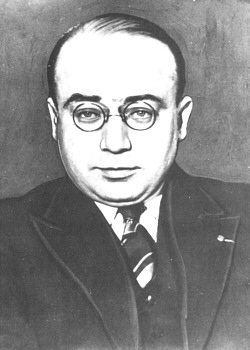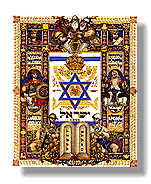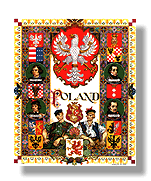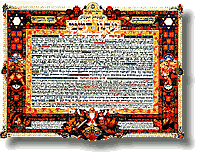 ARTHUR SZYK
ARTHUR SZYK  ARTHUR SZYK
ARTHUR SZYK
Born in 1894 into a middle-class family in Lódz, Poland, Szyk left home at age 15 to study art in Paris. As a young artist, Arthur Szyk experimented with various contemporary styles of the time, including abstraction. But as a lover of history, he felt abstract art left too much to the imagination. He sought clarity in his work and sensed a need to educate. He was drawn to the intricate and decorative style of illumination, in the tradition of 16th-century miniaturist painters. To accomplish this, Szyk created miniature scenes and portraits, illuminating initial letters, decorative and symbolic border patterns, and calligraphy.
Szyk's art extolled his loyalty to three countries: Poland, the homeland of his birth; Israel, the homeland of the Jews; and America, the homeland of freedom. One of his most important works produced during his early years was the 45-page "Statute of Kalisz," which glorified the 13th-century edict granting rights of citizenship to Poland's Jews. In 1931, he was commissioned by the League of Nations to illuminate its charter.
As the urgency of the Holocaust loomed overhead, and specifically in 1939 at the German invasion of Poland, Szyk's life and career altered course. British authorities dispatched Szyk, living in London at the time, to the U.S. to sway American public opinion against the Nazis. Relocating to New York City, he moved away from his established illumination style. He forged a new approach within the genre of political caricature that incorporated both the precise detail and fine craftsmanship of his miniaturist illustrations, combined with the clear message and barbed satire of political commentary.
It was during World War II that Szyk produced his boldest work, as the editorial cartoonist for the "New York Post," producing a steady stream of anti-Nazi cartoons and caricatures for major U.S. publications, including "Time Magazine," "Collier's," "Esquire," "New York Times," and "Chicago Sun." In many newspapers, the drawings were placed on the front page or elsewhere within the news, rather than on the editorial pages, where cartoons usually appear. His work vilified the Nazis, the Japanese, and their cohorts, while galvanizing strength and support for the allies' noble fight for freedom, and exposing the anguished faces of the persecuted victims.
His anti-Nazi propaganda drawings were used to promote U.S. war bonds, and were credited with boosting more sales than any other vehicle. A survey conducted by Esquire magazine published in 1941 proclaimed that Szyk's political cartoons were more popular with young Americans in training under the Selective Service Act than photos of movie actresses or "pin-up" girls.
Szyk died of a heart attack in 1951 at the age of 57. He was survived by his wife, Julia, his son George and daughter Alexandra. During different stages in his life and career, the man who decorated countless works was, himself, decorated by three nations, Poland, France and the U.S.; and in 1948, he proudly succeeded in becoming a citizen of the U.S.
Źródło: http://www.polishnews.com/fulltext/hotnews/polonia28_1.shtml#6
ARTUR SZYK I JEGO DZIEŁO
Twórczość Artura Szyka jest ewenementem w dziejach współczesnego malarstwa miniaturowego. Bogata, nacechowana jego talentem i osobowością twórczość imponuje zarówno bogactwem ilościowym, jak też rozległą i różnorodną tematyką. Szyk był jakby zamknięty w swoim wewnętrznym świecie, chociaż głęboko przeżywał wydarzenia epoki, nie poddawał się modom w sztuce i koniunkturalnym prądom. Jego dzieła wyrastały z konkretnych idei, z fascynacji, którym ulegał i którymi bywał pochłonięty. Toteż z rzadka tworzył pojedyncze miniatury. Tworzył z pasją i benedyktyńską cierpliwości całe cykle poświęcone ważnym wydarzeniom historycznym i postaciom zapisanym w dziejach ludzkości. I, co może się wydawać paradoksalne, jego dzieła, przecież miniatury, były czymś w rodzaju monumentalnego dokumentu.
Rozpoczynając swoją twórczość od historii Żydów - Szyk nawiązuje do dawnego malarstwa iluminacyjnego, szczególnie do prac poświęconych Hagadzie (literaturze religijnej, posługującej się historyczni legendą), powstałych jeszcze przed wynalezieniem druku. Artysta do swoich prac podchodzi z tak ogromną pedanterią i przygotowaniem, że przed podjęciem tematu, tuż po pierwszej wojnie światowej, odbywa podróż do Palestyny by na miejscu odnaleźć ślady starożytnej kultury, by zgłębić krajobraz i klimat kraju, gdzie tkwią korzenie narodu żydowskiego.
Pasją Szyka była nie tylko starożytność żydowska. Jego ogromne zainteresowanie budzi dzieje narodu polskiego, od wieków związane z historią narodu żydowskiego. Nie unika też tematów uniwersalnych, związanych z problemami życia współczesnego i jego prominentnych postaci.
W latach 1926-1928 powstaje najważniejsze dzieło Artura Szyka. uznanego już w świecie mistrza miniatury - sławny cykl STATUT KALISKI. Interesująca jest geneza tego cyklu i samego pomysłu artysty. Przebywał on wówczas w Paryżu i tam dociera do niego wiadomość o przewrocie majowym 1926 roku, dokonanym przez marszałka Józefa Piłsudskiego. Szyk, jak wspomnieliśmy, głęboko interesował się dziejami Żydów na ziemiach polskich. Nie zawsze one były ustane różami, chociaż tradycyjna tolerancja narodu polskiego zapisała się pięknie w historii Żydów. Gdy Szyk w latach dwudziestych przebywał w Paryżu - w Polsce pod rządami Władysława Grabskiego Żydom, szczególnie kupiectwu i rzemiosłu - działo się nie najlepiej. Toteż przewrót majowy dokonany przez Piłsudskiego, byłego socjalistę i liberała przyjaznego Żydom - Szyk przyjmuje niemal z entuzjazmem. Od dawna fascynowała go legenda Legionów, co znajduje zresztą odbicie w jego twórczości. Od dawna też marzyła mu się pełna emancypacja i równouprawnienie Żydów w Polsce. Właśnie Piłsudski rozbudza u Szyka nadzieje i im pragnie poświęcić swój nowy cykl miniatur pod nazwą Statut Kaliski, których zawartość wykracza daleko poza temat nakreślony tytułem.
W zaraniu naszego tysiąclecia życie Żydów na ziemiach polskich nie zawsze układało się idealnie. Chociaż Żydzi, jako kupcy i rzemieślnicy, często wybitni fachowcy, m. in. jako mincerze, pieczętarze, rytownicy byli doceniani przez władców polskich to odrębna obyczajowość, religia, odmienny język, a nawet ubiór - stawały się przyczyną podejrzliwości, niechęci, a nawet nienawiści. Toteż wydarzeniem na miarę historyczną był nadany Żydom w 1264 roku przez zasiadającego na tronie wielkopolski Bolesława Pobożnego 1221 - 1273 przywilej zwany Statutem Kaliskim. Na mocy tego statutu, wzorowanego zresztą na podobnych przywilejach nadanych Żydom w Austrii, Czechach i na Węgrzech - Żydzi zostali poddani sądownictwu książęcemu, co uwolniło ich od drakońskiego, publicznego sądownictwa miejscowych władz i okrutnego często sądownictwa kasztelańskiego. Statut określił Żydów, jako niewolników skarbu (servus camerae), co wprawdzie nakładało na nich obowiązek płacenia księciu pewnych danin, ale zobowiązywało księcia do obrony Żydów. ochrony ich mienia i swobód religijnych praktyk oraz ustanowienia autonomii gmin żydowskich i dawało przywilej swobodnego handlu, operacji finansowych i podróżowania po kraju. Mimo oporów ze strony Kościoła - podobne przywileje nadali Żydom także książęta śląscy Henryk Probus, Henryk Głogowski, Henryk Legnicki i Bolko Legnicko-Wrocławski.
Historyczne znaczenie Statutu Kaliskiego podkreśla fakt, że Kazimierz wielki 1310 - 1370, w rok po objęciu rządów, w 1334 roku potwierdził, a nawet częściowo rozwinął nadany Żydom przywilej Bolesława Pobożnego. Inni monarchowie, m. in. Kazimierz Jagiellończyk, Zygmunt Stary, Zygmunt August, Stefan Batory i królowie elekcyjni - nie tylko utrzymali ten przywilej z pewnymi modyfikacjami, ale także poszerzali prawa i przywileje Żydów, przyczyniając się tym samym do uregulowania współżycia Żydów z Polakami. Nie mogły temu stanąć na przeszkodzie sprzeciwy ze strony duchowieństwa i części szlachty.
Tak więc Statut Kaliski, który profesor Majer Bałaban nazwał wielką kartą wolności żydowskich w Polsce - był dokumentem epokowym i on właśnie zafascynował Szyka w jego rozbudzonej nadziei na wolne życie Żydów w wolnej Ojczyźnie. Statut stał się dla Szyka punktem wyjścia do szerszej historycznej refleksji, był jakby retrospektywą dla dziejów żydostwa na ziemiach polskich. Statut Kaliski Szyka - cykl iluminowanych miniatur - obejmuje wydarzenia od 1264 roku, kiedy książę Bolesław ustanowił przywileje dla Żydów. Całość ujęta została przez Szyka w plansze ozdobione iluminacyjnymi, ręcznymi opisami w języku hebrajskim, łacińskim, polskim, francuskim, włoskim, hiszpańskim, niemieckim i w jidisz. Autor nie ograniczył tego cyklu tylko do epoki powstania Statutu. Ukazuje on tu wkład Żydów do rozwoju gospodarki i kultury Polski, do walk narodowo-wyzwoleńczych - sięgając czasów współczesnych. Znajdujemy tu portret króla Kazimierza Wielkiego, obrońcy Żydów, pokazanego w całym jego majestacie, siedzącego na tronie. Jest tu także król Zygmunt August, przyjmujący żydowskich lekarzy, przysłanych przez sułtana dla ratowania ukochanej króla, Barbary Radziwiłłówny. Na jednej z plansz pojawia się bohaterski pułkownik Berek Joselewicz, pokazany jest udział Żydów w Legionach. Żydzi przy armatach stoją pod polskim orłem, podtrzymywanym przez dwa lwy z napisem Za wolność naszą i waszą. Idea zbratniania żydowsko-polskiego nie raz pojawia się w twórczości Szyka. Przykładem tego jest scena na Placu Zamkowym, gdzie w natarciu Kozaków na patriotyczną demonstrację padli Żydzi i Polacy, a krzyż wypuszczony z rąk demonstrującego Polaka podnosi Żyd Landy i wznosi nad tłum, sam śmiertelnie raniony kulą wroga.
Statut Kaliski Artura Szyka wystawiony był m. in. w Londynie, Paryżu, w Nowym Jorku, stając się prawdziwą sensacją artystyczną. Na wystawie w Londynie wystawę otworzył przywódca syjonistyczny Nachum Sokołow oraz ówczesny ambasador Polski, Alfred Chłapowski, który nabył jeden z pierwszych egzemplarzy Statutu i uroczyście wręczył go Sokołowowi, jako prezent dla Żydów w Palestynie. Pokazanie Statutu w Warszawie, w kwietniu 1929 roku było istnym triumfem artysty. Dzieło poza wystawą zostało pokazane na Zamku Warszawskim prezydentowi Ignacemu Mościckiemu i w Belwederze marszałkowi Józefowi Piłsudskiemu. Zachwycony dziełem marszałek Piłsudski wyraził się, że "Szyk to jedyny artysta, który wie co chce...". Dzieło Szyka było wystawione także w innych miastach, m. in. w Łodzi i we Lwowie.
Artur Szyk zmarł 14 września 1951 roku mając 57 lat, w tym 50 lat pracy artystycznej, bo już jako 7-letnie dziecko tworzył swoje pierwsze rysunki. Chociaż był kontynuatorem wielkich mistrzów miniatury średniowiecza, szkoły francuskiej i niderlandzkiej - jego dzieła w każdym calu są oryginalne i nacechowane jego niezwykłym talentem i wizjonerstwem. Pozostawił monumentalne dzieła, a najważniejsze z nich to właśnie Statut Kaliski, prezentowany w tym wydawnictwie.
Marian Fuks
ARTUR SZYK AND HIS WORK
The work of Artur Szyk is a remarkable phenomenon in the history of modern miniature painting. Rich artistic output, snowing traits of his talent and personality, impresses us both with its wealth, quantity and wide range of themes.
Szyk was sort of locked in his own inner world, although he deeply experienced the events of his epoch. He submitted neither to new fashions in art nor to existing trends. His works developed from real ideas, from fascinations that he experienced and was filled with. For all that he hardly ever created a single miniature, but passionately and with boundless patience he made whale cycles devoted to either important historical events or to distinguished personages of a human history. His paintings were miniatures, yet they were a sort of monumental documents, even if it seems paradoxically.
Szyk began his works with the history of Jews. He referred to the old illuminative paintings, especially to the works devoted to Haggadah (religious literature which makes use of historical legends) works, which had been made before the invention of print. The artist gave his work So much pedantic consideration and preparation that before engaging himself in the subject, he made a trip to r Palestine, just after the world war I, in order to find there the traces of the ancient culture and also to penetrate the landscape and climate of the country where the roots of a Jewish nation were embedded in.
Between the years 1926-1928 the most important work of Artur Szyk, by this time a recognized master of miniature painting - a famous cycle STATUTE OF KALISZ - was finished. The origin of the cycle and of the artist's idea seems to be interesting. In those days he was staying in Paris, and there be learned about the May coup d'etat of 1926 carried out by Józef Piłsudski, a statesman and marshal of the Polish army. Szyk, as it is mentioned above, was deeply preoccupied with history of the Jews in Poland. This History was not always a bed of roses, although the traditional tolerance of a Polish nation was beautifully recorded in the history of the Jews. In the 1920's while Szyk was staying in Paris. the Jews in Poland, tradesmen and craftsmen in particular. were treated unfavourably under Władysław Grabski's government. Far that reason Szyk became enthusiastic over the May coup d'etat, which was carried out by Piłsudski, former socialist and liberal, who was well-disposed towards the Jews. He was fascinated by a legend of the Polish legions for a long time, and this was reflected in his paintings; he was dreaming about full emancipation and equality of rights for the Jews in Poland. It is Piłsudski who raises Szyk's hope. This hope Szyk devotes a new cycle of miniatures entitled STATUTE OF KALISZ, the content of which exceeds far beyond the subject defined by its title.
In the dawn of one thousand years' period of our history the situation of the Jews in Poland did not turn out to he ideal. Though the Jews, such as tradesmen or craftsmen, very often outstanding skilled workmen such as mint's workers, craftsmen who made seals, engravers, were appreciated by the Polish rulers, still their separate customs, religion, different language and even clothes - all that became a cause of suspiciousness, prejudice and hatred. For all that, the privilege called "STATUTE OF KALISZ" granted to the Jews in 1264 by Bolesław Pobożny 1221-1273, who reigned over Wielkopolska (geographical name of a region in Poland, became a distinctive European event. On the ground of this privilege, which was based On privileges granted to the Jews in Austria, Czechs and Hungary, the Jews became the subjects to duke's jurisdiction which exempted a them from severe public jurisdiction of local authorities and from severe jurisdiction of Polish governors. This statute defined the Jews as "slaves of the Treasury" (servus camerae). It obliged them to pay certain tribute to a duke, but at the same time it obliged a duke to protect the Jews, to protect their properties and religious freedom, and to set up the autonomy for the Jewish communities. It also granted them the privilege of free trade, financial transaction and travelling all over the country. In spite of the resistance of Catholic church, similar privileges were granted to tile Jews by I-Henryk Probus, Henryk Głogowski, Henryk Legnicki and Bolko Legnicko-Wroclawski, the Polish dukes from Silesia.
The historical importance of STATUTE OF KALISZ is emphasized by the fact that Kazimierz Wielki (1310-1370) in 1334, a year after succeeding to the throne, ratified and also extended the privilege given to the Jews by Boleslaw Pobożny. The other monarchs like Kazimierz Jagiellończyk, Zygmunt Stary, Zygmunt August, Stefan Batory, as well as tile elective kings, not only remained in force this privilege with some modifications but also extended the rights and privileges for the Jews. This helped to regulate the relationships between the Jews and the Poles. The objections of catholic clergy and a part of a noble class could not interfere with it.
Thus STATUTE OF KALISZ, defined as "Magna Carta" of the Jewish liberties in Poland by professor Majer Bałaban, was a document of epochal importance. It fascinated Szyk and awoke his hopes of a free life for the Jews in a free homeland. For Szyk the statute became a starting point towards extensive historical consideration, it was a sort of retrospect for the history of the Jewry in d Poland. Szyk's STATUTE OF KALISZ - a cycle of illuminative miniatures - comprises the events since 1264, the time when duke Bolesław granted the privileges to the Jews. The cycle as a whole took the shape of illustrations decorated by illuminative, written by hand descriptions in Hebrew, Latin, Polish, French, Italian, Spanish, German and Yiddish. The author did not limit tile cycle to the epoch of the Statute's origin. He presents the Jewish contribution to the economic and cultural development of Poland, their contribution to lights for national independence - moving towards modern times. e can find here a portrait of king Kazimierz Wielki, a defender of the Jews, showing his majesty, sitting on the throne. There is also king Zygmunt August welcoming the Jewish doctors who were sent by a sultan to rescue Barbara Radziwiłłówna, the king's beloved. Berek Joselewicz, a heroic colonel is presented on one of the illustrations. There is also shown the participation of the Jews in the Polish Legions; the Jews, serving the cannons, are standing under the Polish eagle, which is supported by two lions with an inscription "For liberty ours and yours". The idea of Jewish - Polish fraternisation is presented in Szyk's compositions many a time, e. g. the scene at Plac Zamkowy (Castle Square); it shows the Cossacks' attack upon the patriotic demonstration during which, both the Jews and Poles are killed. A cross dropped out of hands of a demonstrating Pole, is raised above a crowd by Landy. a few mortally wounded by enemy's bullet.
STATUTE OF KALISZ was exhibited in London, Paris, New York and in other cities, and it always became a real artistic sensation. The exhibition in London was opened by Zionist leader Nachum Sokolow and Alfred Chłapowski the contemporary Polish Ambassador, who bought one of the first copies of the Statute and officially handed it to Sokolow as a present for Jews in Palestine. The exhibition of the Statute in Warsaw in April 1929 was a tremendous triumph of the artist. Moreover, the work was presented to Ignacy Mościcki, a president of Poland, at the Royal Castle in Warsaw, and at Belweder (Belvedere) to Józef Piłsudski, a marshal of Poland. Józef Piłsudski admired the work so much that he said: "Szyk is the only artist who knows what he wants...". Szyk's work was exhibited in Łódź and Lwów, and in other Polish cities.
Artur Szyk died on the 14th of September 1951, as a fifty seven-year-old man, having worked for fifty years. as he made his first drawings when he was seven. Though he continued the works of great masters of medieval miniature, French and hutch schools - his work was entirely exceptional, showing traits of his unusual talent and visions. He left a monumental work of his lice and his fascinations. STATUTE OF KALISZ, presented in this publication, is one of the most significant of all his works.
Translated by Anna Turlakiewicz
FEATURED ARTIST - ARTHUR SZYK
 Arthur Szyk (1894-1951) was an artist in the tradition of
European manuscript illuminators. His life also gives us a glimpse into the turmoil of a
twentieth century European Jew's life. Born into a scholarly family in Lodz, Poland, Szyk
at 15 went to study art in Paris. During World War I a few short years later, Szyk was
decorated by his homeland for heroism in battle.
Arthur Szyk (1894-1951) was an artist in the tradition of
European manuscript illuminators. His life also gives us a glimpse into the turmoil of a
twentieth century European Jew's life. Born into a scholarly family in Lodz, Poland, Szyk
at 15 went to study art in Paris. During World War I a few short years later, Szyk was
decorated by his homeland for heroism in battle.  Fleeing Poland in 1940, Szyk came to the United States
where he directed his hatred for tyranny and his talents as a caricaturist to the creation
of scathing anti-Nazi cartoons. Showcased in leading American magazines of the day,
notably Esquire and Collins, the popularity of these cartoons and caricatures of the Nazis
infuriated Hitler and led to his personal death order of Szyk's mother.
Fleeing Poland in 1940, Szyk came to the United States
where he directed his hatred for tyranny and his talents as a caricaturist to the creation
of scathing anti-Nazi cartoons. Showcased in leading American magazines of the day,
notably Esquire and Collins, the popularity of these cartoons and caricatures of the Nazis
infuriated Hitler and led to his personal death order of Szyk's mother.
Until his death, Szyk continued to specialize in adapting the detailed style of illumination to a variety of subjects. Working on a commission for Canadian philatelist Kasimir Bileski, Szyk had completed nine of 60 cover pages for an international stamp book when he died. The finished, unsigned lithographs were placed in storage, untouched for almost half a century.
 Now unearthed, the nine finished cover pages which represent the nations of
China, Poland, Switzerland, France, Great Britain, Russia, United States, and Israel are
available. We are fortunate to be able to offer these lithographs, printed by masters
Arthur and Herman Jaffee, in the complete set of 9 prints plus The History of Flight (the
only other existing cover page) or as individual prints.
Now unearthed, the nine finished cover pages which represent the nations of
China, Poland, Switzerland, France, Great Britain, Russia, United States, and Israel are
available. We are fortunate to be able to offer these lithographs, printed by masters
Arthur and Herman Jaffee, in the complete set of 9 prints plus The History of Flight (the
only other existing cover page) or as individual prints.
 In 1948, Szyk completed this illuminated print of the Israeli Declaration of
Independence. Not only do the words express the jubilation felt by the signers and
founders of the State, but the notorious Szyk images and their symbolism tell an entire
story in themselves.
In 1948, Szyk completed this illuminated print of the Israeli Declaration of
Independence. Not only do the words express the jubilation felt by the signers and
founders of the State, but the notorious Szyk images and their symbolism tell an entire
story in themselves.
Szyk's personal attachment to the State of Israel led him to complete the History of Israel cover page in 1949, one of the nine UN coverpages he finished before his death.
As a special project in celebration of the 50th Anniversary of the reestablishment of the State of Israel, Project Judaica Foundation is making available its collection of Szyk's orginal lithographs of the History of Israel and Israeli Declaration of Independence.
Źródło: Project Judaica Foundation.